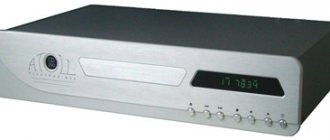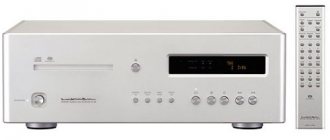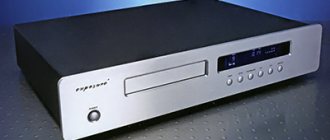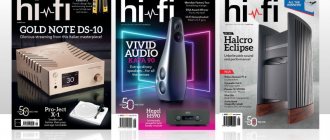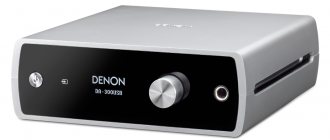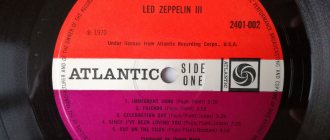Denon DCD-100 player & DRA-100 receiver
Every owner of a CD collection that has been growing over the years, sooner or later faces the question of choosing a CD player to replace the old one. It seems that we have found a suitable option - very decent in class and affordable. Moreover, in combination with an advanced add-on, which will give the audio system the network functions necessary today.
Since CDs as a music medium are gradually disappearing from the shelves of music stores, the choice of new equipment for playing them is naturally narrowing. Many music lovers with extensive collections of CDs believe that this situation is even to their advantage, because it is not necessary to purchase a modern player when there is now a lot of first-class CD equipment on the secondary market at a very attractive price. But getting involved with her is risky. Even when there is an ironclad confidence that the player being purchased, released in “better times” (15-20 years ago), has hardly been used and has a solid service life, one more factor should be taken into account - the availability of a service and repair base. Many specialized chips, lasers and components for drives have long been discontinued and are no longer available. This means that even a minor technical malfunction can be a death sentence for her.
The glossy facade could have had touch-sensitive buttons, like on the DRA-100, but Japanese engineers deliberately installed mechanical ones.
This is, in fact, why we vote for new components. Moreover, we don’t see much reason to spend significant amounts of money on the “latest” CD player. Audio electronics have advanced so much that even relatively simple players can provide a decent level of quality. And it’s better to spend the money saved on the next system upgrade. Believe me, there will be more benefits.
This is exactly the option that we propose to consider now - the brand new DCD-100, released in an elegant “mini” form factor. Obviously, the model was made as an addition to the DRA-100 network receiver, but - an interesting fact - it debuted almost three years later, which gives reason to believe that the newcomer has the most modern hardware.
But I would like to immediately note the rationality of the design. There is nothing superfluous in it. The OLED display is simple, but not sparse in information. The outputs are represented only by a pair of RCA and digital coaxial. The power supply is complete – via a three-wire cable. Additional jack sockets are used to receive commands from the network receiver and, therefore, make it possible to control from a smartphone using the Denon Hi-Fi Remote application for iPhone or Andriod devices.
On a purely mechanical level, everything was also done perfectly. Below there are legs with large elastic supports. The glossy facade could have had touch-sensitive buttons, like on the DRA-100, but Japanese engineers deliberately installed mechanical ones. Well, if the lack of a retractable tray for loading media is alarming, then I assure you that modern retractable drives handle discs carefully enough so that even micro-scratches do not remain on the surface.
The “master clock” for the audio path in this case is the internal generator of the two-channel asynchronous sampling frequency converter AKM AK4136.
Since there is no detailed technical description of the player on the manufacturer’s website, I had to look inside. And it immediately became clear what ensures the monolithic strength of the entire component - a double-hull design. The metal top and bottom panels (by the way, they are pressed through internal rubber dampers) together with the side plastic elements form an external and practically sealed casing. And inside is a durable steel chassis that holds a compact board with a stabilizer and a miniature transformer, a shielded disk drive and a common motherboard. By the way, all cables between the player components are mechanically damped. And in a good way, this is the only way to do it in any component where there are rapidly rotating parts that act as an internal source of vibrations.
Three crystal oscillators are clearly visible on the main board, but none of them are multiples of the CD sampling rate. Their task is to set the clock for control circuits, disk drive drivers and a 32-bit microcontroller (represented by three large modern chips). This is important, since at the same time the task was to ensure reliable reading not only from original CDs, but also from various “blanks”. And the “master clock” for the audio path in this case is the internal generator of the two-channel asynchronous sampling frequency converter AKM AK4136. And it seems that interpolation of digital data before sending it to the Burr Brown PCM5102A delta-sigma DAC (supports up to 32-bit/384 kHz) occurs through a buffer, since we find an Etron EM638165T chip (64 MB high-speed DRAM memory) nearby. This topology allows one to achieve, in addition to high conversion accuracy, significant jitter reduction.
The bass is confident, a little slow, but perfectly full. It is important that this quality is maintained at a decent volume.
Please note: the developers did not introduce the proprietary AL32 algorithm into the digital path of the DCD-100 (why, if it is in the receiver?). And they did not provide support for SACD (even if such media are in the collection, you can always listen to music from the CD layer). As a result, the device has an attractive price. But you won’t find any traces of penny savings here. Take the same analog output, which is implemented using discrete elements and using high-quality capacitors and resistors.
I believe this explains the special character of the sound of the player when you connect it analogue to a serious stereo system. The DCD-100's sound is not branded. The dynamics are a little tighter at highs, but more open in the mids. The bass is quite rich and the detail is quite high, but the pronounced “washed out” nuances and spatial accuracy that distinguish expensive Denon models are not here. In return, the DCD-100 offers a different, emotional interpretation, sometimes even a little more colorful than required. The images in the foreground of the scene are enlivened by this, but in the distant ones they are lost in a kind of “artistic” haze.
However, let's see what happens if you connect the new player to the DRA-100 network receiver. The device is notable not only for its support for various “disembodied” formats and various network/wireless functions. Proprietary processing algorithms are implemented using a 32/40-bit DSP Analog Devices Sharc ADSP21477 and programmable FPGA Altera Cyclone IV matrices. And the path is almost digital from start to finish - a special pulse chipset with direct digital feedback technology DDFA (developed by CSR, which is now owned by Qualcomm) is responsible for amplification. Therefore, it is reasonable to connect two “hundred parts” together only via a digital cable.
The sound immediately adds neutrality and materiality. The bass is confident, a little slow, but perfectly full. It is important that this quality is maintained at a decent volume - no signs of compression appear. Transparency and certainty reign in the space. The dynamics also increase in the main high register, but there are no aggressive shades characteristic of class D amplifiers. Only for the highest “atmospheric” components the range seems to be slightly limited (the filters available at the amplifier output seem to cut off not only the PWM subcarrier frequency, but affect part of the audible band at HF).
We try to replace HECO Elementa 300 bookshelf speakers with Direct Einklang broadband speakers and get a powerful increase in expressiveness and physicality.
Finally, we’ll do a few experiments to find an even more interesting sound. We install a silver-plated speaker cable into the system instead of the usual one, and the problem with “air” is completely solved - even without the aggressive tint of all sonorous components typical for such cables. We try to replace the HECO Elementa 300 bookshelf speakers with broadband Direct Einklang ones and get a powerful increase in expressiveness and physicality - at the cost, however, of some emphasis on the high frequencies (it can be weakened by a timbre block). The most suitable (from those available) were the relatively inexpensive two-way Music Colors. The entire trinity of “player-receiver-acoustics” sounded with such a correct musical balance and such a clear stage that one could draw parallels with some active near-field monitors connected directly to the mixing console. And such an imitation of a mini-recording studio will cost much less not only than professional equipment, but also a large home stereo complex.
SYSTEM
- Speaker systems HECO Elementa 300, HECO Direct Einklang and HECO Music Colors 170 High Energy
- Digital cables InAkustik Digital Coax Premium
- interblock InAkustik Referenz NF-102
- acoustic InAkustik Referenz LS-502 and Referenz LS-1603 Silver
- power InAkustik AC-1502 and P6
CD player Denon DCD-100
Manufacturer: D&M Holdings Inc (Japan)
www.denon.ru
Supported formats: CD Digital Audio, CD-R, CD-RW (mp3, WMA) || Inputs: linear, coaxial || Playback range: 2 - 20,000 Hz || Total Harmonic Distortion: 0.004% || Dynamic Range: 100 dB || Signal to noise ratio: 105 dB || Power consumption: 10 W || Dimensions: 280 x 71 x 305 mm || Weight: 4.2 kg || Price: 39,990 rub.
Network receiver Denon DRA-100
Wireless protocols: WiFi, Bluetooth, NFC || Supported formats: WAV, AIFF, FLAC, ALAC, DSD, mp3, WMA, AAC || Data bit rate: PCM up to 192 kHz/32 bit, DSD up to 5.6 MHz || Inputs: 2 linear, 2 TOSLink, coaxial, USB-A, LAN || Outputs: Linear, Sub, Phones || Output power at 8/4 Ohm load: 2 x 35/2 x 70 W || Distortion Level: 0.004% || Signal to noise ratio: 110 dB || Bass and Treble tone control: +/-8 dB at 100 Hz and 12 kHz || Dimensions: 280 x 104 x 337 mm || Weight: 4.8 kg || Price: 69,990 rub.
share
Tags: DCD-100DenonDRA-100

